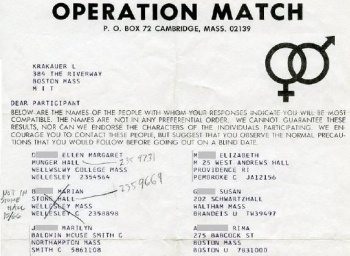Difference between revisions of "Dating Apps"
(→Privacy) |
|||
| Line 2: | Line 2: | ||
| − | '''{{initial|O}}'''<b>nline Dating Applications</b>, or Dating Apps, are [https://en.wikipedia.org/wiki/Online_dating_service web-hosted dating services] accessible as a mobile [[File:Dating-app-icons-tinder-bumble-league-zoosk-okcupid-hinge-2182.jpg|350px|thumbnail|right|The most popular dating apps of 2020]] phone application. They often | + | '''{{initial|O}}'''<b>nline Dating Applications</b>, or Dating Apps, are [https://en.wikipedia.org/wiki/Online_dating_service web-hosted dating services] accessible as a mobile [[File:Dating-app-icons-tinder-bumble-league-zoosk-okcupid-hinge-2182.jpg|350px|thumbnail|right|The most popular dating apps of 2020]] phone application. They often utilize the mobile phone's many affordances, such as GPS location capabilities, on-hand presence, and accessibility to other mobile applications such as photos or videos. |
Dating applications today increase the frequency with which traditional dating takes place, introducing individuals to a variety of possible matches based on characteristics such as location, possible interests or hobbies, and even religious or ethnic preferences. By leveraging various affordances, dating applications allow users to customize their relationship search, supporting any form ranging from a casual hookup to a more committed relationship. | Dating applications today increase the frequency with which traditional dating takes place, introducing individuals to a variety of possible matches based on characteristics such as location, possible interests or hobbies, and even religious or ethnic preferences. By leveraging various affordances, dating applications allow users to customize their relationship search, supporting any form ranging from a casual hookup to a more committed relationship. | ||
Revision as of 09:53, 2 April 2021
Dating applications today increase the frequency with which traditional dating takes place, introducing individuals to a variety of possible matches based on characteristics such as location, possible interests or hobbies, and even religious or ethnic preferences. By leveraging various affordances, dating applications allow users to customize their relationship search, supporting any form ranging from a casual hookup to a more committed relationship.
Contents
History of Online Dating Applications
Technology has been a part of modern dating practices since the 1950s. Operation Match is considered to be the first dating service to incorporate the use of a computer. Launched in 1965, Operation Match utilized the IBM 7090 computer to algorithmically create matches based on responses collected through paper questionnaires. Created by students at Harvard University and Cornell University, Operation Match remained service to help college students find dates rather than foster relationships that could potentially lead to marriage. The service was later bought by a student marketing company after the founders decided to move on to other careers.[1]In the late 1970s, services that allowed video dating began to rise. In 1995, the popular dating service match.com launched and was soon followed by other competitors such as eharmony.com, Ashley Madison, and OKCupid. However, it was not until 2009 that dating became accessible via a mobile phone application. Grindr became the inaugural mobile-first platform by providing a location-based dating application for homosexual men. In 2012, Tinder was founded by a startup incubator Hatch Labs and the dating "swipe" became increasingly popular. By 2013, Tinder was processing over 350 million swipes per day and by 2014, over 1 billion swipes per day.[2] Other popular dating applications such as JSwipe, targeted toward singles of Jewish descent, and Bumble, which requires women to initiate conversations, also launched in 2014. In 2018, it was estimated that nearly 23.8 million [2] adults utilized a dating application of some kind.
Affordances of Dating Applications
Many social media scholars have cited mobility, proximity, immediacy, and visual dominance[3] as affordances that differentiate dating applications from online dating websites. Because dating applications leverage the on-hand presence of a smartphone, users are able to utilize the application at any point in time from any location, thereby increasing the mobility as well as the accessibility of a dating service. While online dating sites provide possible matches by examining the general region in which the user resides, a dating application often returns possible matches within the same vicinity, thereby increasing a user's proximity to a potential match. Dating applications are also more visually driven compared to online dating websites, as images of a potential match take up a sizable portion of a phone screen compared to a computer screen. [3]
As forms of computer-mediated communication, dating applications also exhibit many of the affordances of social network sites. Presentation flexibility, the extent to which a platform affords the ability to engage in self-presentation through a variety of styles, is one such affordance.[4] On Bumble, a user has the ability to not only upload images of their choosing but are also provided with text-boxes and a variety of structured profile fields that allow them to disclose any additional information about themselves, ranging from their religious and ethnic preferences to their smoking/drinking habits and political views. Content and Identity persistence [4] are also key affordances of dating applications as any information a user chooses to disclose remains associated with that user until they decide to change it. As a result, dating applications allow the user to be linked to a stable online identity,[4] greatly reducing anonymity as well as the tendency to create temporary accounts.
Criminal Activities Involving Dating Applications
Rape & Sexual Assault
While dating applications continue to be popular, there are many safety concerns surrounding them, particularly the risk of being raped or sexually assaulted. In the United Kingdom, there were 33 dating applications based rape allegations in 2009, but by 2014 there were 184 such cases, a sixfold increase. [5] In 2015, there were 277 Tinder-related [6] crimes reported, with a majority of the cases involving aggression and sexual assault.In 2019, a 23-year-old male Ahmed Ismail in St. Paul, Minnesota was accused of raping a woman whom he had met on Tinder just shortly after he picked her up for their first date. [7] The woman stated that everything seemed normal at first, but he suddenly pulled into a St. Paul neighborhood nowhere near the restaurant and started to violently kiss and grope her, despite her pleas for him to stop. She said that after he raped her, he told her to get out of his car. The woman then ran to her apartment to call her roommate, who immediately took her to a nearby hospital for an examination. Ismail has now been charged with first-degree criminal sexual conduct.
Similarly in 2018, a 20-year-old woman who matched with college athlete Clay Conaway on Bumble reported that Conaway had forced her to have sex with him after she willingly kissed him during their movie night. [8] She later said that he ignored her anxiety attack and repeated objections, instead stating that "it was fine" as "they were just messing around". Now, Conaway stands on trial for sexually assaulting six different women, many of whom came forward after the 20-year-old described her own experience.
Death
In 2018, a 27-year-old man Danueal Drayton [9] was accused of raping and murdering a 29-year-old nurse Samantha Stewart, whom he had met on Tinder. New York City police have also connected this murder to his involvement in other rapes and killings, most involving women that he had met through dating and ride-sharing applications. Drayton is currently being held on a bail of $1.25 million.On March 13, 2020, a 21-year-old male Adam Rosenberg had been charged with the shooting and killing 28-year-old Jeremy Dentel in February this year. [10] The two had been communicating with one another through 'Find Men', a dating application for homosexuals. Their messages indicated that Rosenberg had wanted to meet in-person, and set-up a time to do so on February 15, 2020 at Dentel's home where Dentel was eventually killed. Rosenberg is currently being held at the Allegheny County Jail in Pittsburgh as he awaits arraignment.
Ethical Issues Surrounding Dating Applications
Commodifying Relationships
One ethical issue that arises from the use of dating applications is the commodification of relationships. Most dating applications, utilizing locations, preferences, and other factors, algorithmically personalize potential matches to the user. As a result, it creates a 'shopping culture' where users are seeking potential partners as they would items at a grocery store, having with them a pre-determined 'list' of qualities they are looking for in a partner. [11] This phenomenon is further exacerbated by the vast amount of choice available to users through a dating application. As users are exposed to the vast 'supply' of potential partners that fit within the realm of their preferences, individuals are more likely to engage in a cost-benefit analysis with potential partners. [11] Relationships begin to be viewed in terms of probabilities and odds as users become aware that there are plenty of options available in the 'marketplace', even if one interaction does not meet expectations.
The 'dating swipe' further complicates the "shopping culture" present in dating applications. While the easy to use affordance can make seeking a potential match engaging, it can also lead to a misappropriation of the applications as a "game". Adopting such a mindset can potentially lead to 'mindless swiping', which further exacerbates the tendency to engage in a cost-benefit analysis. Therefore, the ability to find and create authentic relationships becomes more difficult as users evaluate each other on surface-level characteristics such as attractiveness.[12]
Deception
Another ethical issue surrounding the use of dating applications is the likelihood of deception. Nearly 53% of all Americans fabricate parts of their dating profiles, though the degree to which it is done is varied.[13] To safeguard the authenticity of a user, many dating applications like Tinder and Bumble require the use of a Facebook profile or an existing email address when creating an account. Users are also advised but not required to follow a "one-time selfie" policy to ensure that the images being posted are representative of the user themselves. However, the construction of the profile on the dating application itself can be entirely falsified beyond the images themselves. Most users engage in mechanisms of self-presentation, providing "highlight reels" of their best qualities through their profile. As a result, the lack of full disclosure can lead to possible deception when users engage in offline interactions.Deception can also be more harmful, such as in the case of catfishing. Catfishing, a practice where users deliberately embody fake identities online, can have serious consequences for the victim, ranging from safety threats to financial scamming under the disguise of a romantic relationship. While it is important for users to utilize their personal discretion to avoid being catfished, dating applications like Blume are developing features that may make this process easier. Blume was created with the specific goal to prevent catfishing on dating applications and allows users to verify their matches' images themselves. Users on the application can choose to communicate with their match only if they believe that the profile they see is genuine, not only diminishing the possibility of being catfished but also increasing the possibility of finding a more authentic match.
Privacy
Privacy is also another ethical issue common amongst dating applications. Since many dating applications are location-based and utilize GPS, there is a high likelihood for these applications to experience privacy breaches. In 2019, OkCupid came under scrutiny as users were dealing with an increasing amount of hackers that were changing their login information, though the company denied a possible breach. In November 2013, Quartz found a privacy breach on Tinder: [14] the API design of the application was falsely telling users that a match had been created when it had not been, allowing users to find other users' email addresses.
Furthermore, many dating application sites sell the personal information of their users to thousands of third-party vendors. [15] While some dating applications like Tinder are semi-transparent about the involvement of third-party vendors[16] in their privacy policies, the fact that users' personal information can be accessed by several third-party vendors, sometimes without the users' knowledge, illustrates another potential issue with utilizing a dating application. While the use of other social network sites such as Facebook and Instagram can help improve the authenticity of the users engaged on the platforms, it also provides access to possible images and information beyond what a user discloses on the dating application itself. This also poses a major privacy risk as potential scammers can utilize the connectivity of the various platforms to generate a more in-depth user profile, leading to a greater possibility of various cybersecurity issues such as identity theft. [17]
Change is certain. Likewise with the way a young man and woman meet and then go on a date. You no longer need to break out in cold sweat to meet a girl or man of your dreams. You only need to sit comfortably in the corner of the room or cafe to then solemnly stare at the cellphone screen and choose your potential partner. [18] There are many online dating sites and applications that you can use to meet potential lovers. Starting from Match which was launched in 1995, OkCupid which emerged in early 2000, until Tinder which arrived in 2012 and made the dating patterns of the world's youth evolve even further. [19]
MIT Technology Review launched (10/11), currently more than a third of marriages in the world started from online dating. [20] The number is significant enough to conclude that there has been a change in the community's dating behavior pattern due to online sites and applications. Moreover, the influence of these online dating sites and apps is far more profound. For more than 50 years, researchers have studied the nature of the networks that connect one person to another. As a result, the social network has an odd pattern. One type of network clearly connects each node with its closest neighbors. Other types of networks connect the dots randomly. Both types are different from real-world social networks - where a person is strongly connected to a relatively small group of neighbors, and is loosely connected to people who are further away. This loose relationship then becomes important, because it becomes a bridge between groups of close friends and other clustered groups, and furthermore, connects them to the global community. [21]
References
- ↑ Slater, Dan. The Social Network: The Prequel 28 January 2011. Retrieved 27 March 2020
- ↑ 2.0 2.1 Leskin, Paige. "Dating apps like Tinder, Match, and Bumble are still growing, but analysts predict that growth will 'slow significantly' in 2019" 19 June 2019. Retrieved 12 March 2020
- ↑ 3.0 3.1 Chan, Lik Sam. "Who uses dating apps? Exploring the relationships among trust, sensation-seeking, smartphone use, and the intent to use dating apps based on the Integrative Model" 2017 July. Retrieved 11 March 2020
- ↑ 4.0 4.1 4.2 Devito et.al. "Platforms, People, and Perception: Using Affordances to Understand Self-Presentation on Social Media" 2017 February Retrieved 12 March 2020
- ↑ Rise in first-date rape claims linked to online dating 7 February 2016. Retrieved March 26, 2020
- ↑ Dating apps fuel rise in sex attacks: Sites linked to reports of rape and grooming 10 January 2016. Retrieved March 26, 2020
- ↑ Horner, Sarah. "Man accused of raping a woman he met on Tinder after picking her up for the first date in St. Paul"1 March 2019. Retrieved March 26, 2020
- ↑ Shammas, Brittany. He met his victims on Bumble and Tinder, prosecutors say. His attorneys say women were there to hook up18 September 2019. Retrieved March 26, 2020
- ↑ Cops: Suspect in slaying of New York nurse caught holding a woman captive in L.A. hotel 27 July 2018. Retrieved March 26, 2020
- ↑ Washington, Lisa. 21-Year-Old Charged With Homicide After 28-Year-Old Man Shot Dead In Baldwin Home 19 February 2020. Retrieved March 26, 2020
- ↑ 11.0 11.1 Fetters, Ashley & Tiffany, Kaitlyn. "How Dating Became a 'Market'"25 February 2020. Retrieved March 12, 2020
- ↑ Alexopoulos et.al. "Swiping more, committing less: Unraveling the links among dating app use, dating app success, and intention to commit infidelity" 2020 January. Retrieved on 12 March 2020
- ↑ Hodge, Greg. The Ugly Truth of Online Dating: Top 10 Lies Told by Internet Daters10 December 2012. Retrieved 27 March 2020.
- ↑ "Tinder’s privacy breach lasted much longer than the company claimed on Tinder" Retrieved on March 13, 2020
- ↑ Williams, Robert. "Tinder, Grindr sell personal data in possible violation of privacy laws, study says"15 January 2020. Retrieved 13 March 2020
- ↑ "Tinder's Privacy Policy" Retrieved March 13, 2020
- ↑ Schlesinger, Jennifer. "How cyberthieves are targeting online daters" 22 February 2014. Retrieved March 13, 2020
- ↑ "Pros and Cons of current dating apps" Retrieved on April 18, 2018
- ↑ Hasan, Suhaib. "The Danger of Dating Apps" Retrieved on April 10, 2020
- ↑ "First Evidence That Online Dating Is Changing the Nature of Society" Retrieved on October 10, 2017
- ↑ Andrews, Taylor. "The Pros and Cons of Swiping When You're Lonely During the Holidays" Retrieved on December 3, 2018



